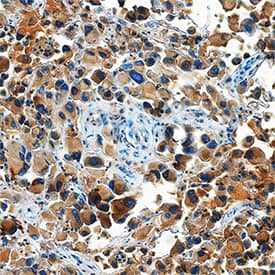Human Ephrin-A5 Antibody
R&D Systems, part of Bio-Techne | Catalog # AF3743


Key Product Details
Species Reactivity
Validated:
Cited:
Applications
Validated:
Cited:
Label
Antibody Source
Product Specifications
Immunogen
Gln21-Asn203
Accession # P52803
Specificity
Clonality
Host
Isotype
Scientific Data Images for Human Ephrin-A5 Antibody
Ephrin‑A5 in Human Melanoma.
Ephrin-A5 was detected in immersion fixed paraffin-embedded sections of human melanoma using Goat Anti-Human Ephrin-A5 Antigen Affinity-purified Polyclonal Antibody (Catalog # AF3743) at 15 µg/mL overnight at 4 °C. Tissue was stained using the Anti-Goat HRP-DAB Cell & Tissue Staining Kit (brown; Catalog # CTS008) and counterstained with hematoxylin (blue). Specific staining was localized to cytoplasm. View our protocol for Chromogenic IHC Staining of Paraffin-embedded Tissue Sections.Applications for Human Ephrin-A5 Antibody
Immunohistochemistry
Sample: Immersion fixed paraffin-embedded sections of human melanoma tissue
Western Blot
Sample: Recombinant Human Ephrin-A5 Fc Chimera (Catalog # 374-EA)
Reviewed Applications
Read 3 reviews rated 4 using AF3743 in the following applications:
Formulation, Preparation, and Storage
Purification
Reconstitution
Formulation
Shipping
Stability & Storage
- 12 months from date of receipt, -20 to -70 °C as supplied.
- 1 month, 2 to 8 °C under sterile conditions after reconstitution.
- 6 months, -20 to -70 °C under sterile conditions after reconstitution.
Background: Ephrin-A5
Ephrin-A5, also known as AL-1, RAGS, LERK-7, and EFL-5 (1), is a member of the ephrin ligand family which binds members of the Eph receptor family. All ligands share a conserved extracellular sequence, which most likely corresponds to the receptor binding domain. This conserved sequence consists of approximately 125 amino acids and includes four invariant cysteines. The A-class ligands have a GPI anchor following the conserved sequence. Ephrin-A5 has been shown to bind EphA2, EphA3, EphA4, EphA5, EphA6, EphA7, and EphA8 (2, 3). The extracellular domains of murine and human Ephrin-A5 share 99% amino acid identity. Only membrane-bound or Fc-clustered ligands are capable of activating the receptor in vitro. While soluble monomeric ligands bind the receptor, they do not induce receptor autophosphorylation and activation (2). In vivo, the ligands and receptors display reciprocal expression (3). It has been found that nearly all the receptors and ligands are expressed in developing and adult neural tissue (3). The ephrin/Eph families also appear to play a role in angiogenesis (3).
References
- Eph Nomenclature Committee [letter] (1997) Cell 90:403.
- Flanagan, J.G. and P. Vanderhaeghen (1998) Annu. Rev. Neurosci. 21:309.
- Pasquale, E.B. (1997) Curr. Opin. Cell Biol. 9:608.
Alternate Names
Gene Symbol
UniProt
Additional Ephrin-A5 Products
Product Documents for Human Ephrin-A5 Antibody
Product Specific Notices for Human Ephrin-A5 Antibody
For research use only